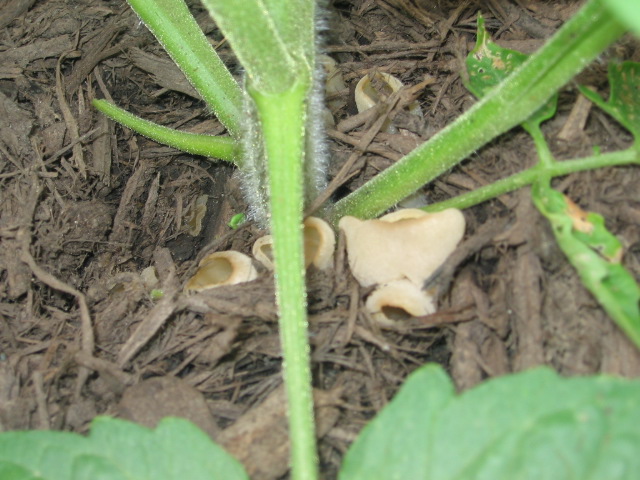
Hello everyone.
Every garden season is a learning experience full of expectation, mystery, successes and failures; we have begun to identify this years fun learning experiences. This picture taken by Michelle on Sunday, June 14th, pictures the fungus that has grown on the mulch and particularly at the base of the tomato plants. Michelle’s picture of the fungus was a great resource in identifying the fungus. I called the Hamilton County extension service to talk to someone about identifying this fungus, ironically the office is located within the Civic Garden Center; links to both these organizations are listed as resources on this blog.
Thanks to Paul at the Hamilton County extension office we know we have “Cup Fungi”
Cup Fungi does not “feed” on live organisms like plants but instead feeds on dead matter, like mulch; why this fungi is growing at the base of the tomato plants is somewhat of a mystery. This fungi should be harmless to our plants but may be poisonous as edibles to humans and/or animals. To verify a poisonous nature we would have to determine the exact species of our fungi within the family of fungus commonly called “Peziza” which would require viewing the mushroom under a microscope. We should treat the fungus as if it is poisonous to humans and animals. Do not eat the fungi and keep away from your eyes, nose, and mouth. Dispose of the fungi in a garbage bag or can, do not put this in the compost pile in case animals are to eat it as well as this fungi will feed on the breaking down matter of our compost pile. If you see this fungi in the garden remove it when possible.
We have tomato bugs
Also pictured is the damaged leaf of a tomato plant from a bug that garden volunteer “van” has simply called “a tomato bug”; he has seen it before and is familiar with it but we lack the appropriate name. The leaf will exhibit many tiny holes in it and on the underside will have tiny nit link eggs that is the larvae of our tomato bug. Treatment for this bug involves simply removing the leaves that we see that have the damage from this bug. The bugs crawl up from the surface and generally attack leaves that are in contact with the surface or are low lying leaves. Throw away the leaves that you removed making sure that they are removed far from the garden.

Great info Mark!
Update on Fungi and Tomato bugs.
The Fungi was removed by hand and I have not seen anymore as of June 19th. The Fungi did not eat the plant but did grow butted up on the stems of the tomatoes causing bruising on the stem of the tomato which makes the plant vulnerable to bugs and disease. The tomato plants look great though.
I did not see any more evidence of the tomato bug damage.
I have this exact same fungus growing at the base of my tomatoes in rose mulch!
i recently found a fungus growing in my mulch it looks very similar to your but on the inside
of the cup part of the fungus there are small flat silver circle pods looks like miniture coins.
what kind of fungus is this?
Hi Natasha.
Our group of gardeners does not include an expert on fungi, we did not identify the exact type of fungus that this is. There are many types of poisonous mushrooms so proper precaution should be taken when handling unknown fungi. We removed our fungus by hand, using gloves and a small hand spade, and got rid of it; it did not continue to be a problem after that.
I have fungus growing in the mulch I put down. It looks like bright yellow scrambled eggs!! It is about 3 inches deep and a round circle of about 18 inches in diameter. It’s in a spot of damp mulch in a circle. What can I treat it with? We scooped it all out and bagged it up . Please advise us, as it is horrible stuff!